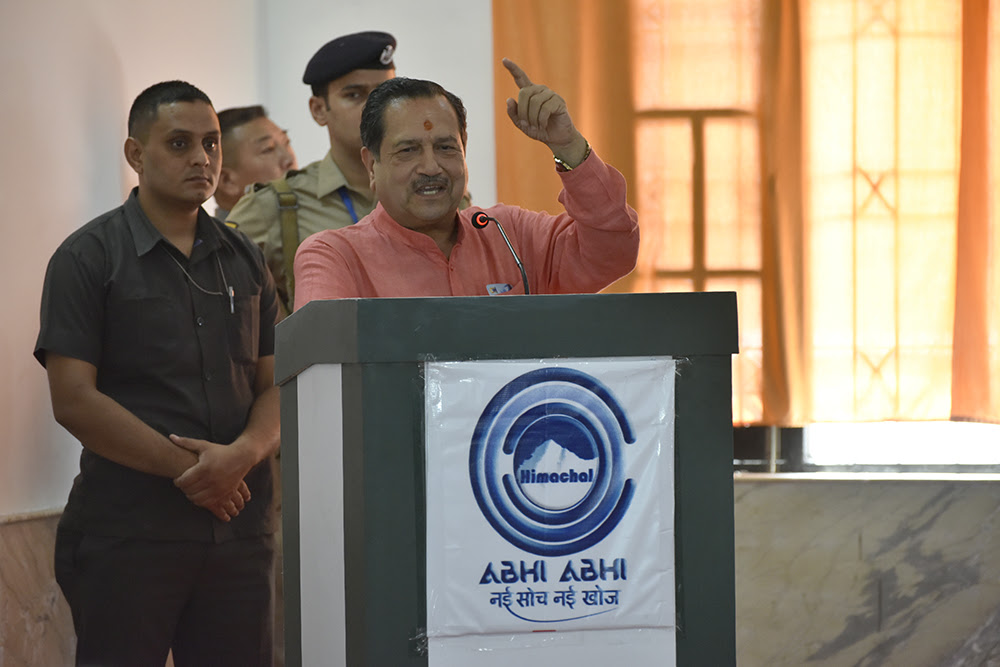

KANGRA: Touting India’s vast ancient knowledge, His Holiness the Dalai Lama on Saturday said India has the potential to foster better knowledge about emotions and how to tackle destructive emotions—that could eventually contribute to world peace.
“All these knowledge coming from Nalanda is Indian tradition. The whole Buddhist world is follower of one of the Indian tradition. If India takes lead in combining its ancient knowledge of emotions and inner world with modern education, I think many Buddhist countries will follow including China,” he said today at Kangra while addressing the 3rd anniversary celebration of Himachal Abhi Abhi, a local News network.
The event was attended by President Dr Lobsang Sangay, Central Tibetan Administration, Kalon Trisur Professor Samdong Rinpoche, Shri Indresh Kumar, RSS leader, Deputy Speaker Acharya Yeshi Phuntsok, Tibetan Parliament-in-Exile, Director of Balaji Media Innovation, Dr Rajesh Sharma, Vice-Chancellor of the Central University of Himachal Pradesh, Shri Kuldip Chand Agnihotri and members of local media and organisations.
“Indian tradition offers the possibility of utilising human intelligence fully and therefore, it can make significant contribution to world peace. Firstly, we must revive this tradition, not through ritual and prayer, but through education.
“Now in this country, over three to four thousand years, different spiritual traditions developed. Regardless of whether it is Jain, Buddhist or Hindu philosophy, all have a common practice of Samadhan, single pointed meditation and Vipassana, analytical meditation; both of which involve mental training. Analytical meditation is something like a weapon to tackle destructive emotions,” he said.
“Ancient India had a highly developed understanding of the depth of mental consciousness. In my discussions with modern scientists, I’ve learned about a great deal about Quantum Physics. However, the Indian nuclear physicist Raja Ramana once told me that concept of Quantum Physics was discovered centuries ago in ancient Indian texts,” His Holiness said.
Referring to the global rise in religious conflicts and violence, he offered India as the shining example of religious tolerance, ahimsa and secular tradition of respect for all believers and non-believers.

“India’s religious tolerance is remarkable. The world needs this value. India’s message of tolerance, ahimsa, karuna and religious harmony is very relevant to today’s world”.
His Holiness mentioned that one of his lifelong commitment is to revive this “ancient yet scientific” tradition in modern India by incorporating it in the education system.
“While I admire and also call myself as a messenger of ancient Indian tradition. Indians are too involved in copying western culture. So now younger people must think about how to revive this ancient Indian knowledge in this country. Now it is the chela’s responsibility to serve as much as we can to revive the ancient Indian tradition. This is not about reviving Buddhism, but revival of science of mind and logical approach”.
“We have around 10,000 monks and few thousand nuns who have spent more than 20 years studying the texts of the ancient Indian tradition. These are the sources to help you. Hence, my fourth commitment is the revival of ancient Indian knowledge in modern India.
“Once it is successfully revived in the country, then you can serve the outside world,” His Holiness said.
His Holiness further mentioned his meeting with Principal of Dharamshala Government College and said that a training of Indian teachers in Ancient Indian logic, psychology and science of mind is in the pipeline.
Commenting on the role of media, His Holiness said, “The role of media is to objectively inform and educate people, based on truth and facts. Today when our world is by and large highly developed and interdependent, the ancient Indian philosophy of Ahimsa and Karuna are highly relevant, which will enable people to live in a happy society”.
During the Q&A session, His Holiness commented on the Tibetan issue. “Regarding the political change, that is difficult to say. China is historically follower of Nalanda tradtiion. Now many Chinese university scholars describe Tibetan Buddhism as an authentic Nalanda tradtiion and some Chinese scholars out of interest to study Tibetan Buddhism want to learn Tibetan langauge. Ofcourse those Chinese who appreciate Tibetan Buddhism are very sympathetic towards Tibetan problem. China is not democratic but totalitarian system, so we will see how much change; it is difficult to predict”.
Vice-Chancellor of the Central University of Himachal Pradesh, Professor Kuldip Chand Agnihotri said, “I am very grateful to His Holiness the Dalai Lama for advocating around the world that the world peace can be possible in the ancient Indian wisdom. He says that India is guru and Tibet its chela, but I think, Tibet is our guru and we are the chelas. Jai Bharat, Jai Tibet, Jai Himachal”.
Shri Indresh Kumar, RSS leader said, “Today’s program is a very auspicious with the blessings of His Holiness the Dalai Lama. India’s ancient tradition is called by many names: Arya tradition, Sanadhan, Hindu and some call it Indian culture. The spirit of brotherhood, love, coexistence has been possible from the land of Bharat. Over 200 intellectuals has written about the greatness of ancient India. When we had moral values, we were the super of the world, the golden example. When we lost our tradition, we lost that status.
“The very Indian culture is indicated when we greet people by saying Namaste. It means that we salute the divinity in the other person. Similarly the Tibetan greeting, Tashi Delek expresses respect, love and peace. This is the culture that His Holiness has been spreading across the length and breadth of the world”.
Thanking His Holiness, Director of Balaji Media Innovation, Dr Rajesh Sharma said, “It was with your blessing that we started this venture. Your advice was to couple the freedom of media with duties and responsibilites that society demands form this institution. We have tried to follow your instructions and your words will further guide us as guiding light in future”.
His Holiness last visited the institute in May 2016 to inaugurate Himachal Abhi Abhi News App.

















